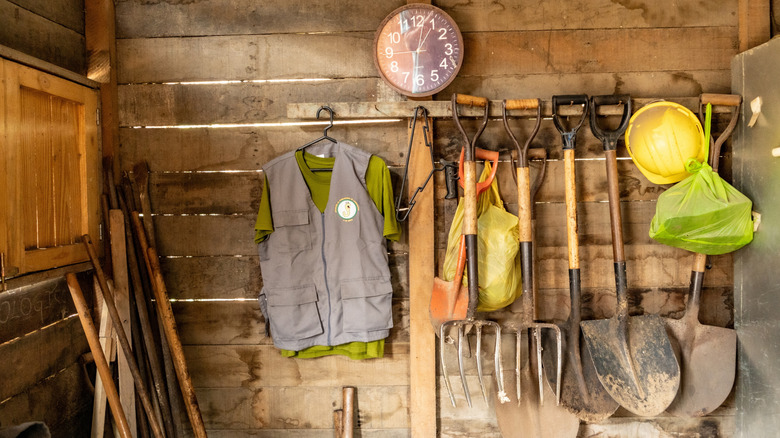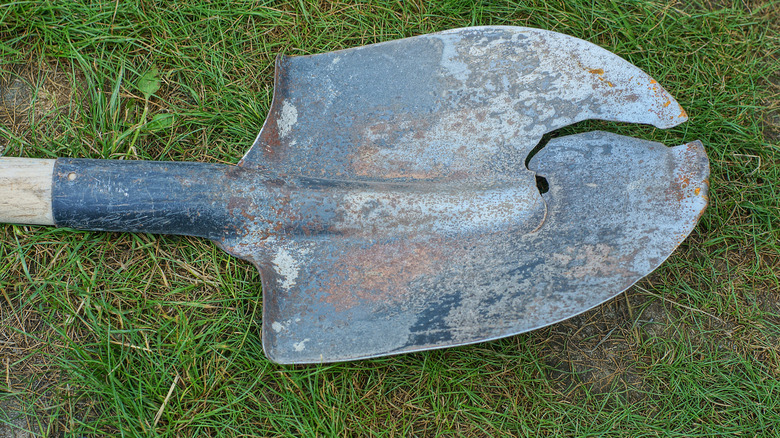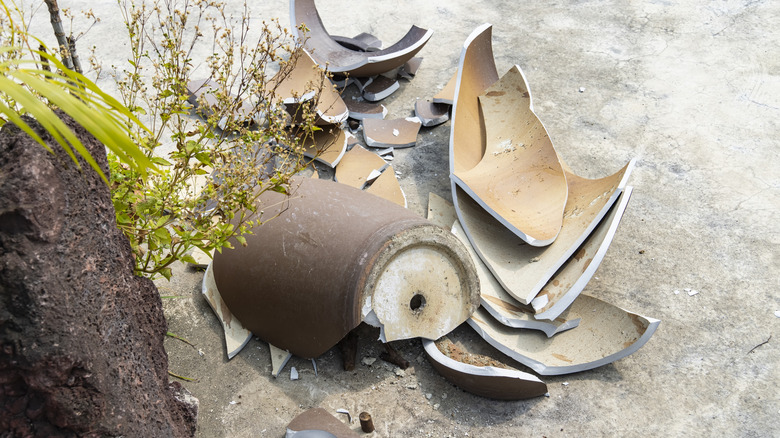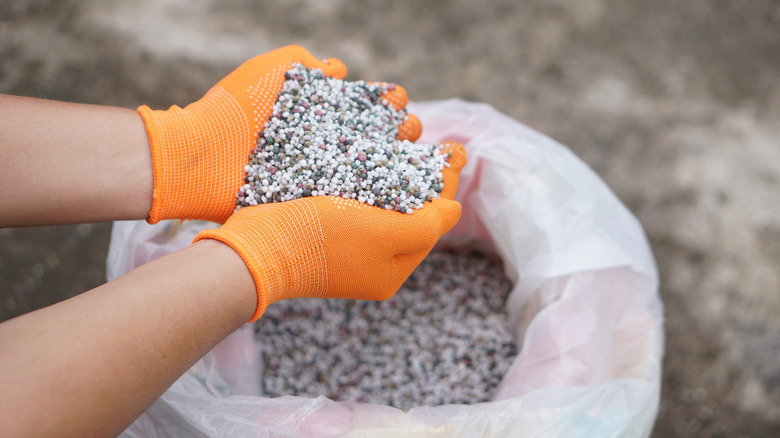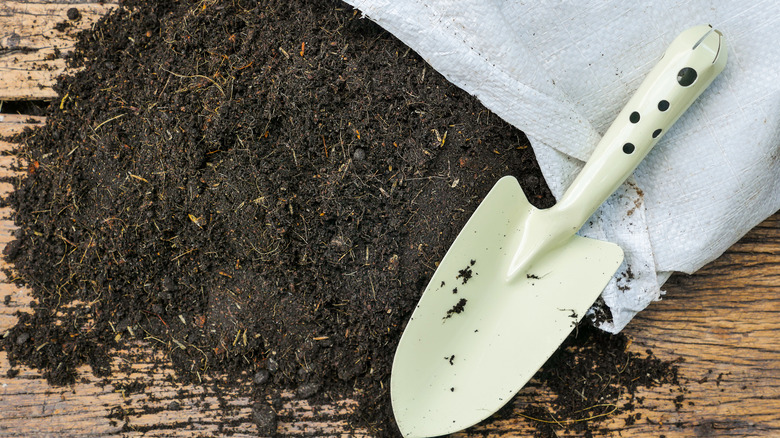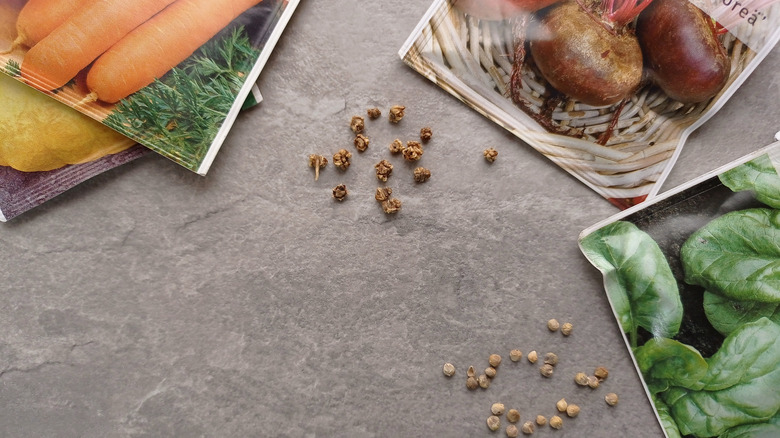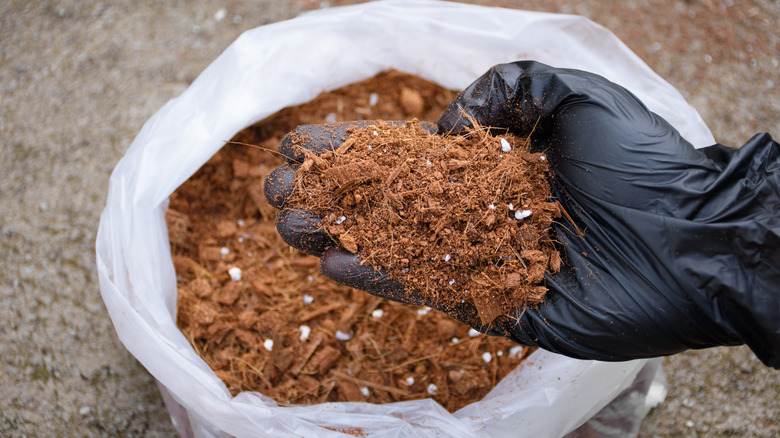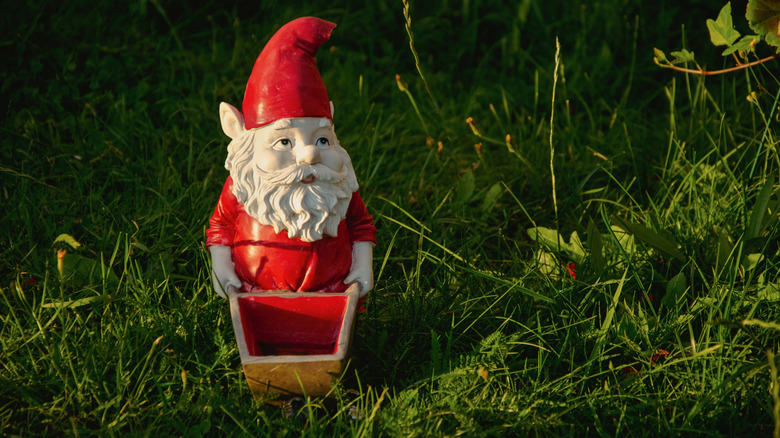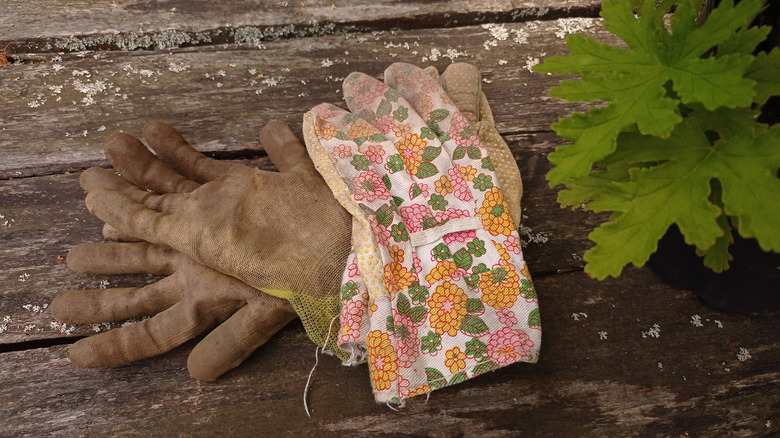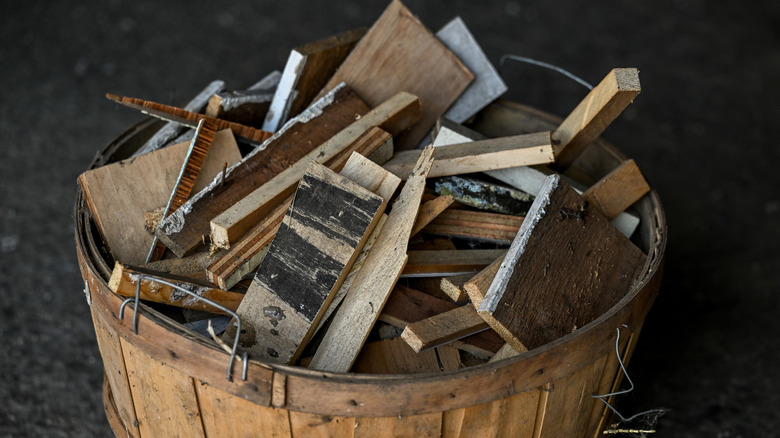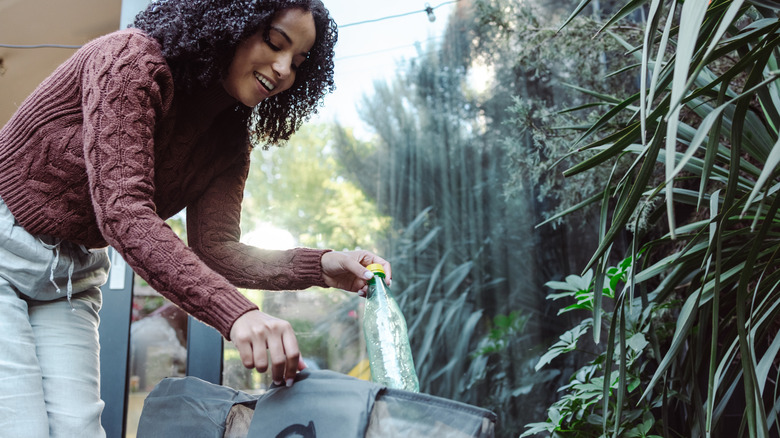Declutter Your Space By Throwing Away These 10 Garden Items You'll Never Need Again
We may receive a commission on purchases made from links.
When you think about your beautiful outdoor space and colorful garden, hopefully it brings a smile to your face. Thriving plants, lush, green grass, and carefully thought-out decor pieces are probably just a few elements of your yard that you work so hard to take care of. Now, be honest. When you think about your shed or garage where you store all the items you use to keep your garden looking so incredible, does it also bring a smile to your face? If you answered "no," because that storage and prep space has turned into a disastrous mess, it's time to do something.
Fortunately, you don't have to make huge changes or sacrifice any of your favorites to get your gardening zone in order. Decluttering the area by getting rid of the gardening items you'll never need again can have a huge impact. You might not realize just how much stuff there is that you don't need, so we've put together some pointers on what you can toss (or potentially recycle or repurpose) to reclaim the space and make sure that it is working for you.
Unusable tools
One of the first things you should do when decluttering your gardening items is to look through all of your tools. Are any of them broken, too rusty to be rescued, or otherwise unusable? If so, it is time for them to go. There is no reason to let something you'll never utilize take up space that could be used to hold something else — or prevent you from keeping what you do use organized and easy to access. Before simply tossing these tools in the trash, where they'll end up in a landfill, reach out to your local recycling center or metal scrapyard. Old tools can often be recycled, though not all centers may accept rusty ones.
Beyond any irreparable tools, you should also clear out any equipment that you know you simply won't use. This could include items that you have any duplicates of (do you really need four trowels?). It could also include specialty tools that you no longer have a need for (such as a fruit picker if you had to cut down the apple tree in your backyard). As long as these tools are in usable condition, there's no need for them to end up in a landfill either. Consider donating them to a neighbor or a nonprofit organization that is starting a garden.
There are also some brilliant ways to repurpose garden tools around the home, such as making a plant trellis using long-handled implements. You can also turn old wheelbarrows into planters, or spades into bird feeders, signs, and more. However, only save tools for such a project if you have a plan to complete it quickly — you don't want them to continue adding unnecessary clutter indefinitely.
Broken planters
Now is also the time to say goodbye to any broken planters and pots. Unfortunately, due to their fragile nature, clay planters are easy to break if they're inadvertently dropped or pushed off the edge of a table. Plastic planters can also crack if dropped or squashed. Plus, over time, UV rays, temperature fluctuations, and other environmental conditions can cause the plastic material to degrade, leaving it brittle and easy to break.
Regardless of the type of planters you have or the reason they are broken, they are no longer usable and shouldn't be allowed to add to the clutter. Depending on where you live, you may be able to recycle broken plastic pots. Check their base for the plastic number, which may be #2 (polyethylene), #5 (polypropylene), or #6 (polystyrene), and check to see if your local recycling center will accept them.
Unfortunately, broken clay pots cannot be recycled. The process of firing the clay alters its chemical makeup. This makes it impossible to turn it back into clay. So, unless you're ready to start a project in the very near future to repurpose the broken plant pots in your home or garden, these may need to be tossed in the trash.
Fertilizer that is no longer usable
If, as you are going through your gardening supplies, you find a bag of fertilizer that got hidden in a corner or the bottom shelf of a cabinet, it may also be destined for the trash. Fertilizer doesn't last indefinitely. Depending on the type of fertilizer you have and how it was stored, it may or may not still retain its potency. Let's start with liquid fertilizers. When stored properly, these may last for up to 10 years. However, they'll only last for this long if they're unopened. If your liquid fertilizer has already been opened for more than a year, then it has likely started to degrade due to air exposure and may not still deliver quite the same nutrient levels.
Granular fertilizers have the potential to last significantly longer. However, you'll want to give the granules a quick inspection to see if they are still in good condition. If they're clumping together, this is an indication that they've been exposed to too much moisture and that the fertilizer won't perform as effectively. If this describes your granular fertilizer, your best bet is to let it go and purchase a fresh bag when you're ready to apply it. You may also have a fertilizer blend with active ingredients (such as those that serve a dual purpose of controlling weeds or deterring pests). These don't last as long, even if they're not clumping, because of the shorter shelf life of the herbicides or pesticides in their formulations. If you've had the bag for more than a few years, it's time to toss it.
While we're on the topic of tossing, keep in mind that fertilizer shouldn't be chucked into the trash or, worse, flushed down the drain (which is against the law). Instead you will need to drop it off at your local hazardous household waste depo, or consider donating the fertilizer to a community garden center, or someone in need who can't afford supplies for their yard. While old fertilizer might not be as potent as a fresh supply, this doesn't mean it can't still be useful in a garden somewhere.
Potting soil that has gone bad
If you have some older bags of potting soil, you may assume that they will last forever. After all, they're just dirt, what could possibly make them go bad. However, there are some flaws to this reasoning, and it is possible that you'll need to throw away that old potting soil. First, potting soil is more than simply dirt. It also contains organic materials that help improve the structure of the soil. Peat moss, one of the organic materials added to many potting soils, decomposes within about two years. If the soil is too compacted, it is an indication that the peat moss has decomposed already. Using it could jeopardize your plants because it won't retain moisture like potting soil should.
Mold and bacteria may also grow in potting soil if it isn't stored correctly. As you can probably guess, using such soil could threaten the health of any plants that you place in it. Not all molds will necessarily wreck your plants (some are even beneficial) but certain fungi can be very harmful, such as fusarium, so it might be wisest to play things safe with fresh soil if your old bag looks moldy.
Also, if you notice an odor reminiscent of rotten eggs when you smell the soil, toss it. This odor is caused by a bacterium that grows in compacted or damp soil. If you open the bag and see mold growing, it likely means that the soil was too moist when its bag was closed up. This soil also needs to be dumped, but not in the trash. Any soil you want to dispose of should be taken to a yard waste disposal site.
Seed packets that are no longer viable
It's possible that you may also want to get rid of seed packets. However, the answer to "Do garden seeds expire?" is a bit complex. The shelf life can vary depending on the seed, and the way you store them will also impact their viability. Start by assessing the storage conditions of any seeds that you find. Let go of those that were not stored properly (in a dry, cool, and dark environment).
Next, you'll want to assess just how long you've had each packet and decide based on its contents whether the seeds are likely still good. Many vegetable seeds can remain viable for between two and four years. However, some, like onion and parsnip seeds are really only good for one year, while radish and cucumber seeds may last up to five years. Many annual flower seeds, including lobelia, calendula, and poppies, can remain viable for three or more years. Some, though, such as vincas, geraniums, and asters, only have a shelf life of about one year.
If you're not certain how long you've had the seeds or if they are viable, you can perform a relatively quick test to check. Wrap 10 or more seeds in a damp paper towel, put the towel into a closed plastic bag, and leave it somewhere warm for about a week (or however long the seeds are supposed to take to germinate). After a week or so, open up the paper towel to see how many seeds sprouted. If a high percentage of them germinate, then they're likely still good. However, if fewer than half sprouted, you should just toss them.
Bags of mystery seeds, potting mixes, or other products
Life happens. You put some extra seeds, specialty soil mix, or other items in a bag to save them for later. At the time, you're absolutely certain you'll remember what they are and when you bagged them. However, when you come across that bag in the future, you have absolutely no idea what is actually inside it or how many months (or even years) it has been sitting around.
In these cases, you're best off throwing out (or properly recycling, if applicable), the item in question. We've already covered that seeds don't last forever and that potting soil, fertilizer, and other products can also go bad. When you factor in the added complication of not even knowing what is in the bag, you'd be taking a gamble if you were to try planting it or adding it to your garden bed.
Any decor items that you don't love anymore
If you have garden decor that is cluttering your garage, shed, or basement, it might also be time to kick it to the curb. Chances are, if the decor is inside the house or a storage area instead of being displayed in your garden, that you don't actually like it anymore or have replaced it with something new. So, why are you still holding on to that ceramic gnome, mushroom, or random wire decoration if it no longer makes you happy?
Of course, if the decor items are still in good condition, they don't belong in the trash. You can consider donating them or even offering them up to your local Buy Nothing Group. If you haven't already replaced these old items, treat yourself to a few new decor pieces for your lawn and garden — but only if you're certain you're going to leave them outside and not let them add to the clutter in your storage area.
Torn gardening gloves
Gloves are a must-have when weeding your garden and doing other garden chores like pruning. If you're an avid gardener, you may even have a few pairs of gardening gloves. As you're decluttering your space, take some time to give them all a quick inspection and toss any that are torn or too badly worn to be serviceable. While you may think that a small tear in a glove shouldn't impact its fit or utility, you'll actually be taking a risk any time you wear it.
Gardening gloves do more than simply keep your hands from getting dirty. They are a crucial piece of safety gear. Besides the beneficial organisms soil contains, it can also harbor pathogens and harmful bacteria like Sporotrichosis (which can cause what's commonly known as "rose gardener's disease") and even tetanus. If you're wearing ragged gloves with holes in them, you're more likely to get a cut or scratch on your hand, leaving an opening on your skin where these bacteria could get into your body. If your only pair of gardening gloves are torn, toss them and opt for a heavy-duty, quality pair, such as the Wells Lamont Women's HydraHyde Gardening Gloves, that will offer optimal protection.
DIY projects that you'll never finish
You know what they say about good intentions. You may have several DIY projects started for your outdoor space. But, as the weeks, months, or years went by, you never had the chance to finish them. Perhaps you were just too busy, or maybe you changed your mind about the value of adding the finished product to your space and just never picked it back up.
Whether you were planning to upcycle thrifted glassware into bespoke garden decor or had grand ideas of repurposing pool noodles for the garden, if you haven't completed the project, you should probably let all the supplies go. If you decide you really want to keep something, set a definitive date to finish it by. Clearing the clutter is essential for improving the aesthetics and functionality of your space, so you can easily access the tools and supplies you do need on a daily basis.
Random trash that's mounted up which you meant to repurpose for gardening
There are lots of ways to reuse things like plastic bottles, glass jars, tin cans, egg cartons (you name it!) in the garden. But, this can also mean that your gardening station or storage area starts accumulating way more waste items than you can reasonably repurpose. If a plethora of soda bottles, pickle jars, ice cream sticks, and takeout containers are taking over your potting shed, garage, back patio — or wherever else you keep your gardening supplies — it's time to send some of it to the recycling.
Start by assessing how many of each item you can reasonably use. Glass jars can be ideal for rooting cuttings but are you likely to propagate 50 plants at a time? There are many empty food containers that make for perfect DIY seed starters, but if you're getting takeout regularly, eat a lot of eggs, or bring paper coffee cups home on the daily, then keeping half a dozen in the garage isn't necessary, as you'll always have a fresh supply. Once you know what can go, grab a trash bag and fill it with any of those items, plus other garbage you might spy, like empty seed packets, price tags from potted plants you purchased, empty shopping bags, etc. To be recycled, some items might need a rinse, especially if they're still sporting residue like dried coffee dregs or have gotten dusty during storage.
